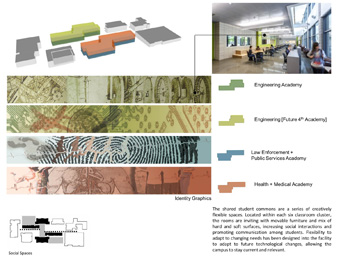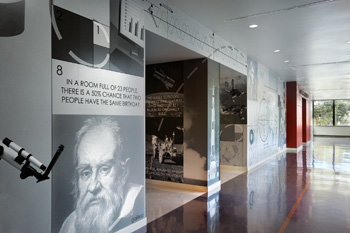Beyond Wayfinding: Environmental Graphics in Learning Spaces
-8888-500px.jpg) Guest Blog by Emily Koch and Kate Mraw
Guest Blog by Emily Koch and Kate Mraw
Architectural signage is necessary to inform people how to navigate through a campus or building. In designer-speak, this signage is commonly referred to as wayfinding. While it’s an important aspect of signage, environmental graphics can accomplish so much more than that — influencing mood and behavior, increasing student engagement, reinforcing school spirit and pride, and creating a culture of community — all while directing people to their destination.
There is a concept in psychology called “priming” that refers to how our unconscious mind is affected by sensory input such as words and color. In 1996, John Bargh studied the effects of priming and found that people primed with words related to politeness waited nearly 10 minutes to interrupt a researcher, whereas people primed with words about rudeness only waited half that time before interrupting, and a neutral control group landed in between.

_1390.jpg) Environmental graphics are a way to "prime" occupants and visitors through visual stimuli in the form of large-scale, digitally-printed vinyl wall coverings, dimensional letters, acrylic or metal plaque signage, etched images or words into concrete, or even the simple application of color, thereby setting the tone for the culture of the space.
Environmental graphics are a way to "prime" occupants and visitors through visual stimuli in the form of large-scale, digitally-printed vinyl wall coverings, dimensional letters, acrylic or metal plaque signage, etched images or words into concrete, or even the simple application of color, thereby setting the tone for the culture of the space.
In architectural application, environmental graphics have long been reinforcing corporate branding, identity and culture for years in office environments.
What about learning environments? If students’ and teachers’ moods and behaviors could be improved through priming with positive thoughts and encouraging messages, a graphics package is a worthy investment. School signage and graphics can promote school spirit and pride, provide educational information about sustainability, give small learning communities or schools-within-a-school their own identity, and foster a collaborative school culture.
SOCIAL CONNECTIONS
Graphics of school logos, mascots, mottos and colors reinforce school spirit and pride, particularly around athletics facilities. Just as brand control and identity are important to businesses, a school’s mascot and logo should be consistent and cohesive throughout sports uniforms, signage, gymnasium striping, directional signage, and banners.
Cohesion and consistency strengthen the power and recognition throughout the school and larger community, including the impression on visiting sports teams. Athletics are often a large part of students’ school experiences and activities, increasing their involvement within school events, encouraging healthy social interaction and habits and creating fond memories for them to look back on and return as a supportive alumnus.
Signage can also be used as a teaching tool, explaining the sustainable features of the building, such as energy efficiency, building performance and the importance of recycling. Subtle graphics or facts strategically placed near waste receptacles can serve as reminders for people to recycle. An informational icon can remind those that exit a room to turn off the lights. Other educational graphics can manifest as subtle details and reminders of the purpose of the place; of the beauty in subjects like math and geometric principles, of historical examples of positive role models, or of interesting facts that inspire life-long learners to delight in the joy of discovery and knowledge.
CREATING IDENTITY + COMMUNITY
Smaller school size is one of the greatest indicators of student success and achievement. However, instead of reducing enrollment at larger high schools, many schools are creating schools-within-a-school, also called “small learning communities” or SLC’s. Many SLC’s are focused on career pathways or academies. Environmental graphics can craft the identity of these academies to create distinction between the smaller focused community and the larger school community, using color, iconography, imagery, and words that resonate with each academy’s focus. The clear identities of the academies helps foster a more collaborative culture of community, where each student gets to know each other well enough to care not just about themselves, but for other students’ success. An increased sense of community can also encourage pride of ownership in their campus, reducing graffiti and vandalism.
The benefits to designing environmental graphics in learning environments are numerous, beyond the required wayfinding signage in each project. The words of an inspiring community leader or an interactive display make people stop and think. As we look for strategies to create a positive school culture, we inspire life-long learners.
Emily Koch is an Interior Designer and Project Coordinator for integrated sustainable firm LPA Inc. A LEED Accredited Professional, Koch works in educational design and has transformed outdated schools into leading-edge 21st century learning environments across California. She received a Bachelor of Science in Interior Design from the University of Texas, Austin School of Architecture.
Kate Mraw is an Associate and Interior Designer at California-based LPA Inc. Her K-12 educational spaces encourage collaboration, experimentation and instruction. Mraw, a LEED Accredited Professional, received her Bachelor of Science in Interior Design from the University of Texas, Austin School of Architecture.

.jpg)
